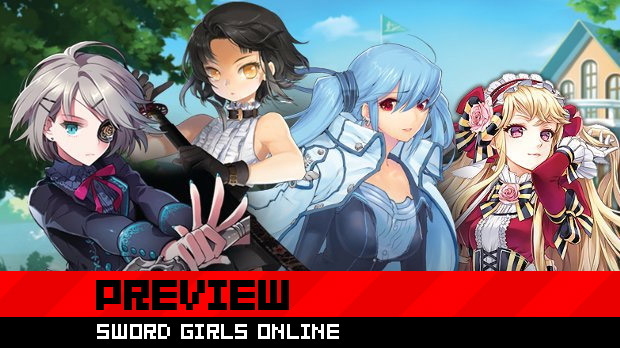Zeonix is no stranger to online trading card games. After reasonably successful runs with Fantasy Masters and Ragnarok TCG, the company set out to create one of the deepest online card games on the market with impressive strides in both gameplay and deck building as well as some top-notch anime artwork.
Sword Girls Online entered closed beta this month and, from what I’ve seen so far, they’re well on their way to delivering on those promises and releasing one of the most involved and addicting card games I’ve ever played.
Sword Girls Online (Flash)
Developer: Zeonix
Publisher: Chang You
To be released: TBA
If you’ve ever played a trading card game, you’ve got a solid idea of how this all works. Gather cards, build a deck, defeat opponents, and repeat. What breaks up that cycle, however, is the deck-building process. You’ve got the option to purchase cards. At the moment, game tokens cost $0.01 each with pre-built decks coming in at 500 tokens ($5) and single cards at $0.35. Alternatively, cards can be constructed by combining materials found in the game’s dungeons. These are earned after every battle, regardless of the result. Even if you lose, you’ll earn something so that next time you might have more of a chance. More often than not, it can be hard to progress in games like this when losing only reduces your odds of winning next time. Thankfully, that’s hardly an issue in Sword Girls.
It’s a fairly deep system, but it can be tedious. Training a card takes a minimum of six hours, and with no system in place to sort out cards that have or have not received training it can be a chore just finding a particular card amongst the sea of duplicates and distractingly beautiful anime portraits.
Again, it’s all just the slightest bit tedious. At times it can feel like a Facebook game, albeit a top-shelf Facebook game, with the way menus are set up and the frequent instances of “wait six hours” to complete a task. Getting lost in the processes and menus as a beginner is to be expected but, once it’s all said and done, a solid deck is worth the effort.

The combat itself is deceptively strategic. With your character card taking up their post in the center, you have six slots available for follower cards (the front line) and spell cards. Each of these cards has a designated size and your on-field cards cannot exceed a total size of ten. Obviously, more powerful cards will have a higher size and will most likely be less common while weaker, smaller cards are practically throwaways.
On the surface, strategy is negligible. I spent the first hour or so of my play time just clicking cards … and I won a few matches. After a while though, it became clear that you have to optimize not only the cards on the field, but the cards in your hand as well. As followers are destroyed, your character will lose health equal to their sizes. This further enforces the balance between strong and weak cards. I found that more often than not, a full field of weak cards could deal respectable damage without taking too much of a toll on your own health.
My first thought was that Sword Girls was more of a deck-building sim than it was a card battle game. To the contrary, deck building was emphasized to allow for a more streamlined battle experience. Developer Zeonix put it this way: “Deck construction is so important because there is no room for useless, or should I say, cards that don’t synergize well with your deck’s theme or overall strategy.” The gameplay is so quick, you have to build your deck with a certain degree of precision to be able to perform well, and their options definitely allow for that.

The single-player “Dungeon” portions are varied, and there are plenty of them. A handful of difficulty levels, each with their own selection of dungeons and boss characters equate to a good deal of single-player content. Right off the bat, I noticed that each AI opponent I faced utilized different strategies. The boss of the first beginner level dungeon was plenty of challenge for me, but they promise that “later dungeon bosses are absolutely ridiculous to beat.” I can’t wait.
While the AI is more than formidable, I found the PvP to be particularly exciting. Intentionally difficult programs are tough, but nothing presents more of a challenge then a knowledgeable, prepared human opponent. Pairing yourself up with a random opponent is simple enough; clicking “fight” instantly throws you into a queue where there are plenty of rabid players ready to show you just how bad you are at the game. That said, I totally wasn’t bad at the game … nope.


